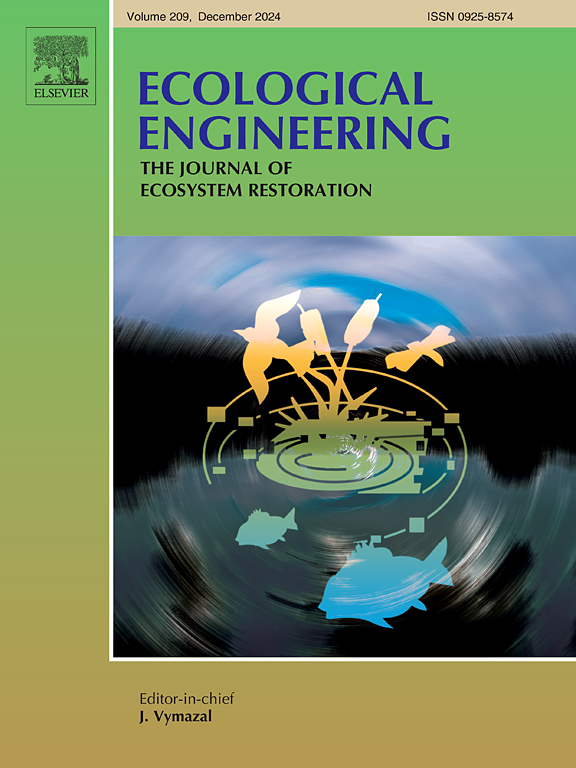Mechanistic study on the role of design and management factors in regulating nitrogen treatment performance in constructed wetlands
IF 3.9
2区 环境科学与生态学
Q1 ECOLOGY
引用次数: 0
Abstract
Surface flow constructed wetlands (SFCWs) are increasingly recognized as an effective solution for nitrogen in agricultural drainage, with their performance influenced by design and management. However, the mechanisms by which these factors regulate nitrogen removal remain unclear. Understanding these mechanisms is crucial to promoting and applying SFCWs. In this study, field pilot-scale SFCWs were subjected to orthogonal tests to investigate the mechanistic influence of aspect ratios (the ratio of length to width) (2:1, 4:1, 8:1), plant species (Typha latifolia, Juncus effusus, Vallisneria natans), and hydraulic loading rates (HLR) (0.23, 0.45, 0.68 m d−1) on nitrogen removal. The results showed that N2 emission (21.4% ∼ 67.4%) was the primary pathway for total nitrogen (TN) removal, followed by plant uptake (0.9% ∼ 58.6%), sediment storage (8.8% ∼ 44.0%), periphyton assimilation (2.9% ∼ 7.8%), NH3 volatilization (1.9% ∼ 6.4%), and N2O emission (0.4% ∼ 1.1%). Aspect ratio and HLR had weak effects on nitrogen treatment performance and transformations. In contrast, plant species significantly affected TN removal, nitrate nitrogen (-N) removal, NH3 volatilization, and N2 emission. The highest reaction rates for TN removal, -N removal, and N2 emission were observed under Vallisneria. However, NH3 volatilization peaked under Juncus. Water pH and plant biomass could explain the impact of plant species on N2 emission and NH3 volatilization. Overall, plant species selection is more crucial than aspect ratio and HLR, with Vallisneria as the preferred plant species for efficient TN removal.

设计与管理因素对人工湿地氮处理性能调控的机理研究
地表流人工湿地(SFCWs)被越来越多的人认为是农业排水中氮的有效解决方案,其性能受到设计和管理的影响。然而,这些因素调节氮去除的机制尚不清楚。了解这些机制对于推广和应用SFCWs至关重要。在本研究中,通过田间中试规模的SFCWs进行正交试验,研究了长宽比(2:1,4:1,8:1)、植物种类(Typha latifolia, Juncus effusus, Vallisneria natans)和水力加载率(HLR) (0.23, 0.45, 0.68 m d - 1)对氮去除的机理影响。结果表明,N2排放(21.4% ~ 67.4%)是去除总氮(TN)的主要途径,其次是植物吸收(0.9% ~ 58.6%)、沉积物储存(8.8% ~ 44.0%)、周围植物同化(2.9% ~ 7.8%)、NH3挥发(1.9% ~ 6.4%)和N2O排放(0.4% ~ 1.1%)。宽高比和HLR对氮处理性能和转化的影响较弱。相比之下,植物种类对TN去除、硝态氮(NO3−-N)去除、NH3挥发和N2排放有显著影响。对TN、NO3−-N的去除和N2排放的反应速率最高的是缬草。而NH3挥发在Juncus时期达到峰值。水体pH和植物生物量可以解释植物种类对N2排放和NH3挥发的影响。总体而言,植物物种选择比宽高比和HLR更重要,缬草是高效去除TN的首选植物。
本文章由计算机程序翻译,如有差异,请以英文原文为准。
求助全文
约1分钟内获得全文
求助全文
来源期刊

Ecological Engineering
环境科学-工程:环境
CiteScore
8.00
自引率
5.30%
发文量
293
审稿时长
57 days
期刊介绍:
Ecological engineering has been defined as the design of ecosystems for the mutual benefit of humans and nature. The journal is meant for ecologists who, because of their research interests or occupation, are involved in designing, monitoring, or restoring ecosystems, and can serve as a bridge between ecologists and engineers.
Specific topics covered in the journal include: habitat reconstruction; ecotechnology; synthetic ecology; bioengineering; restoration ecology; ecology conservation; ecosystem rehabilitation; stream and river restoration; reclamation ecology; non-renewable resource conservation. Descriptions of specific applications of ecological engineering are acceptable only when situated within context of adding novelty to current research and emphasizing ecosystem restoration. We do not accept purely descriptive reports on ecosystem structures (such as vegetation surveys), purely physical assessment of materials that can be used for ecological restoration, small-model studies carried out in the laboratory or greenhouse with artificial (waste)water or crop studies, or case studies on conventional wastewater treatment and eutrophication that do not offer an ecosystem restoration approach within the paper.
 求助内容:
求助内容: 应助结果提醒方式:
应助结果提醒方式:


